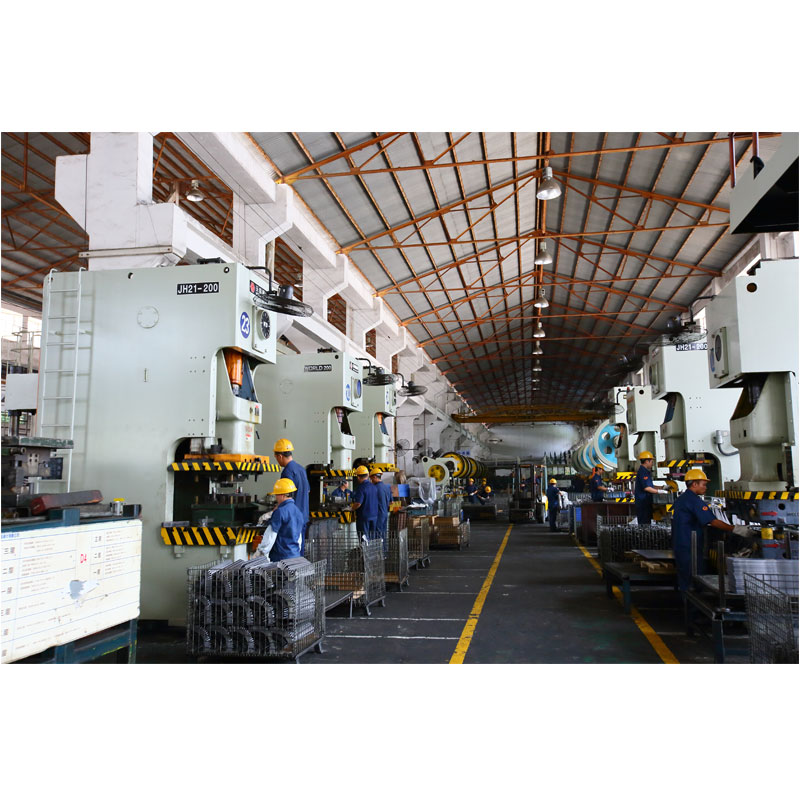Sheet metal stamping parts forming process
Stamping is a metal material processing method in sheet metal processing. It is mainly aimed at metal materials. It uses pressure equipment such as stamping machines to force the material to deform or separate to obtain the actual required sheet metal processing parts.

Types of stamping processes for sheet metal processing:
1. Blanking
A general name for a stamping process that extracts materials. It includes: blanking, punching, punching, grooving, sectioning, chiseling, edge pressing, cutting, etc.
2. Appearance design
The main purpose is to cut off the excess parts of the material and ensure that the stamping process meets the specifications and model requirements.
3. Tongue cutting
Cut a hole in a certain part of the material, but not all of it is cut. It is common to cut only three sides of a rectangle and leave one side unchanged. The main function is to determine the step distance.
4. Expansion
This process is not widely used. It is common for tubular parts to expand the end or one end outward into a trumpet shape.
5. Shrink mouth
Just the opposite of flaring, it is a stamping process in which the end or a certain point of a tubular part must be narrowed inward.
6. Punching
In order to better obtain the hollow part of the part, the complete material will be separated through the punch and the knife edge to obtain the corresponding hole size.
7. High precision stamping
When the cross-section quality of stamping parts requires a full bright strip, it can be called "fine blanking" (note: ordinary blanking sections are divided into four parts: sag zone, bright zone, fracture zone, and burr area)
8. Fully bright blanking
Unlike high-precision stamping, full-bright blanking can be obtained in one step as much as possible.
9. Deep hole punching
When the diameter of the product is smaller than the thickness of the material, it can be considered as deep hole punching. The difficulty of punching is reflected in the fact that the insert pin is easy to break.
10. Make convex hull
A process that creates a protrusion on a flat material and has relative application requirements
11. Forming
Many friends control forming as sheet metal bending, but they do not take it seriously. Because sheet metal bending is a type of forming, it refers to the general name of all fluid material processes.
12. Sheet metal bending
A basic process that obtains relative angles and shapes by brittle fracture of flat materials through convex and concave mold inserts.
13. Pressure ribs
This is generally used in sheet metal bending forming inserts for inclined-angle sheet metal parts. It is mainly based on a structure that creates convex pits in the material at the bending position of the sheet metal part to reduce the material's resilience and ensure angle stability.
14. embossing
A process in which unique designs are pressed into the surface of the material through inlay needles, which generally include: embossing, small black dots, etc.
15. Roll round
A type of molding manufacturing process, which is a process based on folding the product shape into a ring shape.
16. Turn holes
The process of warping the threads of stamped parts to obtain side edges of a certain height.
17. Straighten
Mainly for situations where product flatness requirements are high, when stamping parts have flatness errors due to stress fields, the straightening process must be used to adjust them.
18. Plastic surgery
When the product is formed and the angle and shape are not the same as the basic specifications, you must consider adding a step of adjustment to ensure the angle is stable. This process is called "shaping"
19. Stretching
Generally refers to the process of obtaining hollow parts from flat materials through methods, which is called the stretching process, which is mainly carried out through convex and concave molds.
20. Keep stretching
Generally refers to a drawing production process that uses one or four molds to draw materials at the same position multiple times in a material strip.
21. Loosening and deepening
Continuous drawing and deep drawing both belong to the relaxation drawing series, which means that the wall thickness of the parts after drawing will be smaller than the thickness of the material itself
22. Stretching
The basic concept is similar to that of convex hull, which is to convex the material. However, deep drawing generally refers to car parts, which belongs to a relatively complex molded product series, and its deep drawing structure is also relatively complex.
23. Construction project model
A collective name for molds that only carry out one stamping process during the entire stamping process in a set of molds.
24. Composite model
A collective name for molds that can carry out two or more different stamping processes in one set of molds.
25. Stamping mold shell
A set of molds are fed by a material belt, and two or more processes are arranged in sequence, and are fed sequentially along with the stamping process to finally achieve a qualified product.
Stamping/fine blanking improves production efficiency, provides safety guarantee, and saves labor costs. We can provide you with overall solutions for compressor casings, air-conditioning accessories, home appliance components, and automotive sheet metal parts to realize turnkey projects and realize unmanned workshops. We are already taking action on high-quality products.

